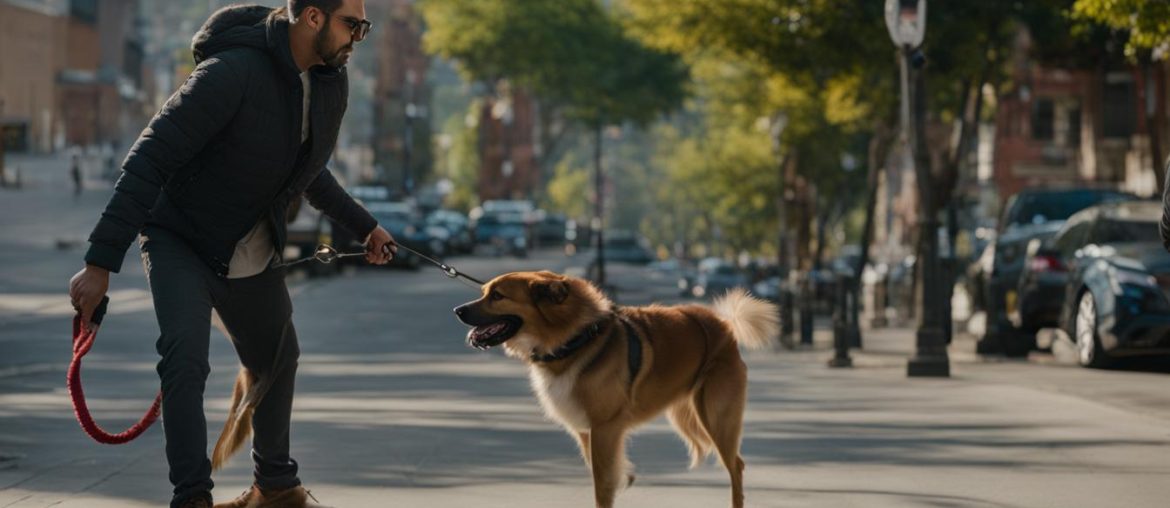Are you tired of your dog constantly pulling on the leash during walks? Don’t worry, you’re not alone. Many dog owners struggle with this common behavior. But with the right techniques and training, you can teach your furry friend to walk calmly and comfortably by your side.
Before diving into leash training, understand why dogs pull on the leash in the first place. Dogs naturally pull because they want to explore their surroundings and reach their destination faster. However, this behavior can be managed and corrected through proper training and consistent effort.
Key Takeaways:
- Understanding why dogs pull on the leash is crucial for effective training.
- Patience, consistency, and positive reinforcement are key factors in stopping dog pulling on the leash.
- Using the right equipment, such as harnesses, can make a significant difference in leash training.
- Starting leash training in a non-distracting environment and using positive reinforcement techniques, like treats, can help reinforce desired behavior.
- Consistency and commitment are essential for successful leash training.
Why Dogs Pull on the Leash
Dogs pulling on the leash is a common behavior that many dog owners experience. Understanding why dogs engage in this behavior can help in addressing it effectively. There are several reasons why dogs pull on the leash:
- Desire for exploration and engagement: Dogs are naturally curious creatures and are eager to explore their surroundings. When they are on a leash, they may pull to get closer to interesting smells, sights, or sounds.
- Lack of exercise or mental stimulation: Dogs that are not adequately exercised or mentally stimulated may have excess energy, which they may try to release by pulling on the leash.
- Desire to reach a destination: Dogs may pull on the leash because they are excited to reach their destination, whether it’s a park, a friend’s house, or simply a change in scenery.
- Untrained or inconsistent leash walking: Dogs that have not been properly trained to walk on a leash may pull due to a lack of understanding of what behavior is expected of them. Inconsistent training methods can also contribute to leash pulling.
By understanding the reasons behind leash pulling, dog owners can take appropriate steps to address the behavior and train their dogs to walk calmly on the leash.
“Understanding why dogs pull on the leash is the first step in addressing the behavior effectively.”
Continued in the next section…
Getting Started with Leash Training
Leash training is an essential skill for all dogs, ensuring their safety and your peace of mind during walks. To get started with leash training, there are a few key steps to follow.
Step 1: Preparing for Leash Training
Prior to starting leash training, ensure that your dog’s daily exercise and mental stimulation needs are met. A tired dog is more likely to be focused and receptive to training. Additionally, gather the necessary equipment for leash training, such as a suitable leash and collar, harness, or head collar. Choose equipment that is comfortable and secure for your dog, allowing you to maintain control without causing harm or discomfort.
Step 2: Choosing the Right Environment
Begin leash training in a non-distracting environment, such as your backyard or a quiet park. This will help your dog focus on the training and minimize the chances of them being overwhelmed or easily distracted. As your dog becomes more comfortable and responsive, gradually introduce them to busier environments to further reinforce their leash manners.
Step 3: Using Positive Reinforcement
Positive reinforcement is a highly effective method for leash training. When your dog walks calmly on a loose leash, provide verbal praise, treats, or other rewards that they find motivating. This positive association will encourage your dog to repeat the desired behavior. Consistency is key, so always reward your dog for walking without pulling and ignore any pulling behavior.
Step 4: Gradual Progression
Leash training is a gradual process, so be patient and progress at your dog’s pace. Begin with short walks and gradually increase the duration and distance as your dog becomes more comfortable and responsive. Use consistent cues, such as “heel” or “let’s go,” to signal your dog to walk beside you. Try to reinforce the desired behavior and provide plenty of positive reinforcement along the way.
By following these steps and dedicating time to regular training sessions, you can lay a solid foundation for successful leash training. Try to be patient, consistent, and always prioritize your dog’s comfort and well-being during the training process.

The Importance of Consistency in Leash Training
Consistency is a crucial element in leash training your dog. By maintaining a consistent approach, you can effectively communicate your expectations and reinforce desired behaviors. Consistency helps your dog understand what is expected of them and reduces confusion during the training process.
When it comes to leash training, consistency encompasses several aspects. Firstly, it involves using the same walking method throughout the training sessions. Whether you choose to use a harness, collar, or head collar, stick to one method so that your dog can become accustomed to it and understand how to respond to your cues.
Consistency also extends to your expectations for your dog’s behavior on the leash. Set clear guidelines for walking manners and reinforce these consistently. For example, if you want your dog to walk beside you without pulling, reward them every time they exhibit this behavior and correct any instances of pulling. This will help your dog understand the desired behavior and make training more effective.
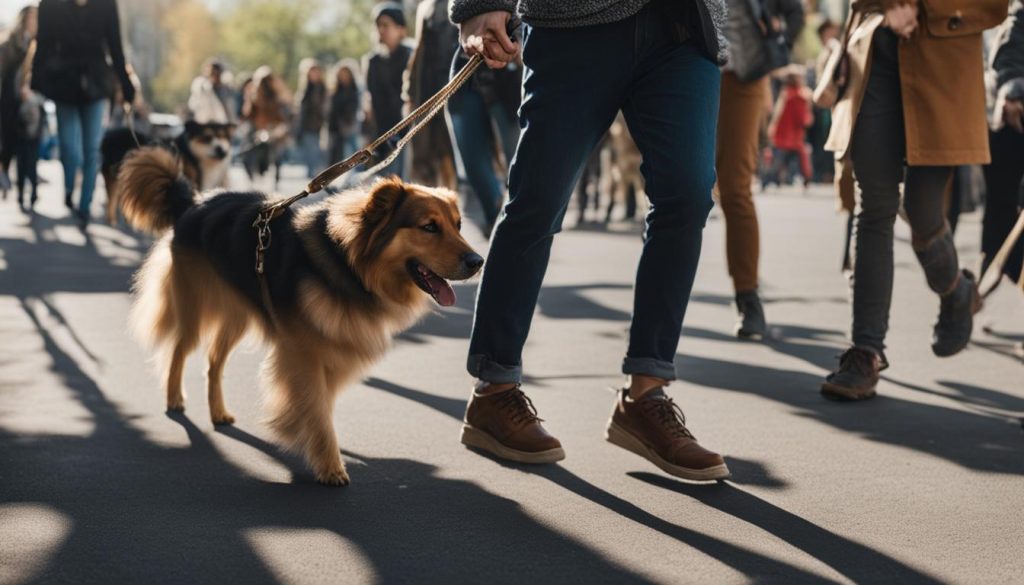
Additionally, consistency applies to your use of cues and rewards. Use the same verbal cues, hand signals, or clicker sounds consistently to signal your dog’s desired behavior. Reinforce this behavior with rewards, such as treats or praise, each time your dog responds correctly. Consistency in cues and rewards strengthens the association between the behavior and the reward, reinforcing the training process.
By maintaining consistency in leash training, you set clear expectations for your dog and create a structured training environment. This consistency helps your dog understand what is expected of them and reduces any confusion or frustration. With time, patience, and consistent training, you can achieve success in leash training and enjoy stress-free walks with your furry friend.
Using Power Steering with the Right Equipment
Choosing the right equipment for leash training is crucial in teaching your dog to walk calmly on the leash. One effective tool for leash training is a front clip harness. A front clip harness, such as the Freedom No-Pull Harness, provides power steering and prevents your dog from leaning in and pulling. This type of harness redirects your dog’s forward motion, making it easier for you to control their movements. It helps distribute the leash pressure more evenly across their chest, discouraging pulling behaviors. Using a front clip harness can be especially useful if your dog has a strong pulling instinct or tends to lunge towards distractions.
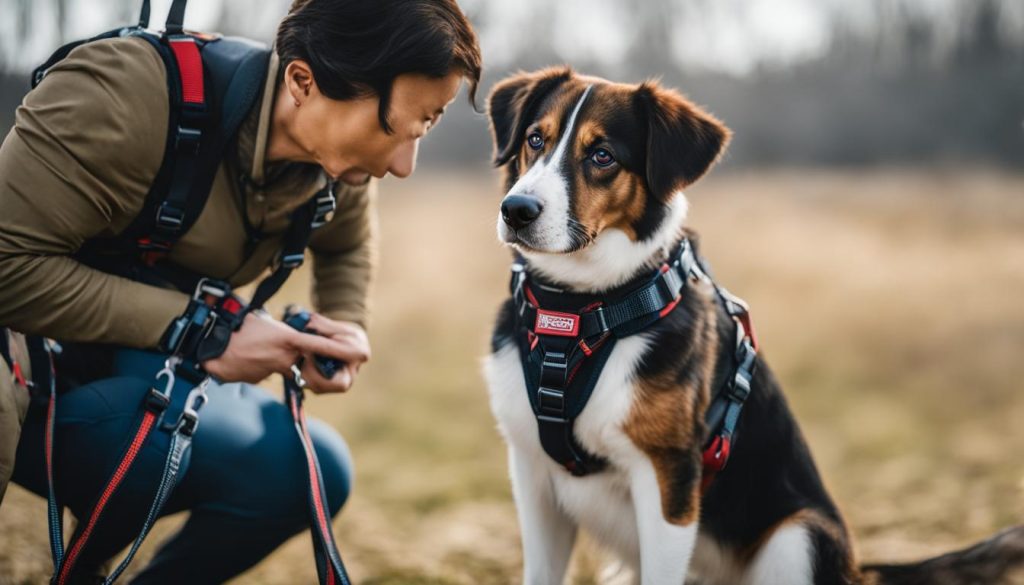
Another important aspect of choosing the right equipment for leash training is selecting the appropriate leash. A plain six-foot nylon, rope, or leather leash is generally recommended. These types of leashes are durable and provide you with better control. Avoid using retractable leashes or long lines, as they can encourage pulling and make it difficult to maintain consistent control over your dog. I recommend that you find a leash that feels comfortable for you to hold and doesn’t cause any discomfort or pain to your dog. Experiment with different leash options to find the one that works best for both of you.
In addition to a front clip harness and the right leash, using power steering techniques while walking your dog can further enhance your leash training efforts. Power steering involves using quick, gentle movements to redirect your dog’s attention and change their trajectory. For example, if your dog starts to pull, you can quickly turn and walk in the opposite direction, encouraging your dog to follow you. By doing this, you regain control of the walk and reinforce the importance of walking at your side. Try to use positive reinforcement, such as treats or praise, to reward your dog for walking calmly on the leash. With the right equipment and power steering techniques, you can make leash training a positive and successful experience for both you and your dog.
| Benefits of Using the Right Equipment for Leash Training |
|---|
| Provides power steering and prevents pulling behaviors |
| Redistributes leash pressure for better control |
| Allows for quick redirection and change of direction |
| Enhances the effectiveness of positive reinforcement |
Using Movement to Your Advantage
Movement plays a crucial role in leash training. When your dog pulls on the leash, you have two options: stop immediately and wait for slack in the leash before moving forward, or turn and head in the opposite direction. Both methods require patience and consistency, but they can be highly effective in teaching your dog to walk calmly on the leash.
By changing direction and making yourself more interesting, you can redirect your dog’s attention and encourage them to follow your lead. When you stop and wait for slack in the leash, you communicate to your dog that pulling will not get them where they want to go. Turning and walking in the opposite direction helps break the pulling behavior and encourages your dog to pay attention to you. Try to reward your dog with treats and praise when they walk politely on the leash.
Using movement to your advantage also helps prevent leash pulling in the first place. If you anticipate that your dog is about to pull, you can proactively change direction or redirect their focus to prevent them from pulling. For example, if you see a squirrel ahead that may trigger your dog’s prey drive, quickly turn and walk in the opposite direction to divert their attention. By being proactive and using movement strategically, you can set your dog up for success and make leash training more effective.
Exercising Your Dog before Walks
Exercising your dog before walks is an essential step in managing their energy levels and making leash training more effective. By engaging in physical activity before heading out for a walk, you can help tire your dog out and reduce their urge to pull on the leash.
One of the best ways to exercise your dog before walks is by incorporating playtime into your routine. You can play fetch in the yard or take them to a nearby park for a game of frisbee. These activities not only provide physical exercise but also mental stimulation, which is important for a well-rounded and contented dog.
I recommend that you remember that the goal of the walk is to teach your dog to walk nicely on the leash, not to provide all their exercise needs. By exercising your dog beforehand, you set them up for success in leash training. They’ll be more focused and attentive during the walk, making it easier to reinforce good leash manners.
| Benefits of Exercising Your Dog before Walks |
|---|
| Reduces excessive energy |
| Increases focus and attention |
| Enhances mental stimulation |
| Improves overall behavior |
By incorporating pre-walk exercise into your dog’s routine, you can create a calmer and more enjoyable walking experience for both of you. Try to start with moderate exercise and gradually increase the intensity as your dog becomes more conditioned. With regular exercise and consistent training, you’ll be well on your way to stopping your dog from pulling on the leash.
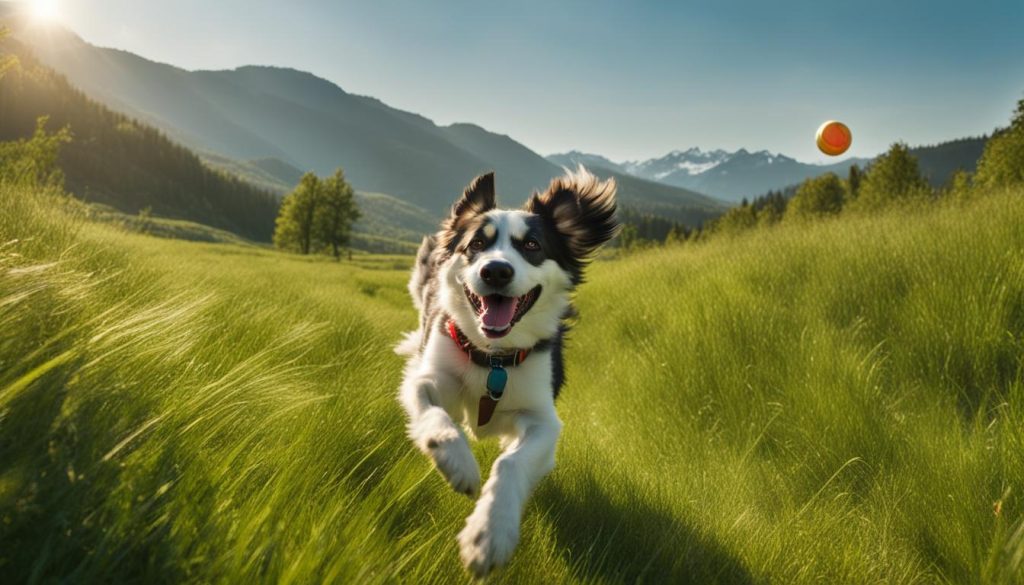
Training Your Dog to Have Good Leash Manners
When it comes to leash training your dog, consistency, patience, and positive reinforcement are key. With the right approach, you can teach your furry friend to walk calmly on the leash, making your outings together enjoyable for both of you. Here are some tips for training your dog to have good leash manners:
- Use treats in leash training: Treats can be a powerful tool in reinforcing good behavior during leash training. Make sure to use top-quality treats that are soft and smelly, as these are more enticing for your dog. Whenever your dog is walking without pulling, reward them with a treat. This positive reinforcement will help them associate loose leash walking with positive outcomes.
- Reinforce good behavior: In addition to using treats, reinforce your dog’s good behavior in other ways. Praise them with encouraging words, petting, or a belly rub when they walk nicely on the leash. By consistently rewarding and reinforcing good leash manners, you will encourage your dog to continue exhibiting the desired behavior.
“Consistency, patience, and positive reinforcement are key in leash training your dog.” – Professional Dog Trainer
Try to set your dog up for success by making it easy for them to do the right thing. Start leash training in a non-distracting environment and gradually introduce more challenging situations as your dog progresses. Be patient and consistent in your training efforts, as it takes time for dogs to learn new behaviors. By training your dog to have good leash manners, you’ll be able to enjoy peaceful and enjoyable walks together.
Summary:
In conclusion, training your dog to have good leash manners requires consistency, patience, and positive reinforcement. Use treats as a powerful tool to reward and motivate your dog during leash training. Reinforce good behavior through praise and physical affection. Set your dog up for success by starting in a non-distracting environment and gradually increasing the difficulty level. With dedication and consistency, you can achieve peaceful walks with your well-behaved dog.
| Tips for Training Your Dog to Have Good Leash Manners |
|---|
| Use treats in leash training |
| Reinforce good behavior |
| Set your dog up for success |
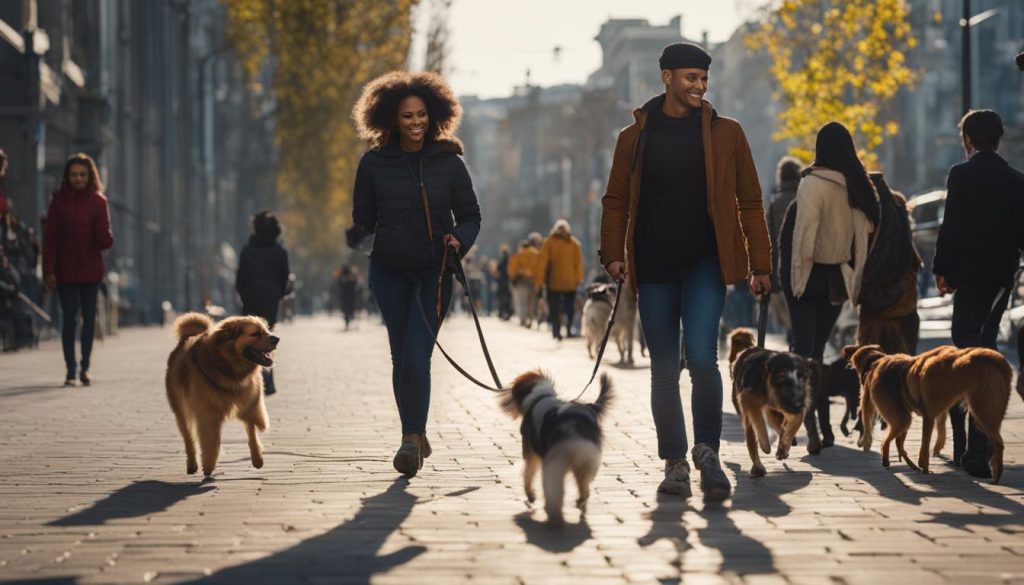
Training your dog to have good leash manners is an investment of time and effort, but the rewards are well worth it. By using treats and positive reinforcement, you can encourage your dog to walk calmly on the leash. Try to be patient, consistent, and supportive throughout the training process. Soon enough, you’ll be enjoying peaceful walks with your well-behaved canine companion.
Setting Your Dog Up for Success
When it comes to leash training, setting your dog up for success is crucial. By choosing the right time for walks and selecting appropriate routes, you can create an environment that promotes positive behavior and minimizes distractions. Here are some tips to help you set your dog up for success in leash training:
- Timing is everything: Pick a time for walks when your dog is calm and less likely to be excited or easily distracted. Avoid peak hours when there may be more people, other dogs, or loud noises that can trigger pulling behavior.
- Choose the right route: Opt for routes that are less crowded and have fewer distractions, such as parks or quiet residential areas. Avoid routes with excessive foot traffic or areas where your dog may encounter triggers, like squirrels or other animals.
- Gradually increase difficulty: Start with simple, low-stress walks in familiar surroundings before gradually introducing more challenging environments. This allows your dog to build confidence and focus on leash manners without feeling overwhelmed.
- Be patient and consistent: Leash training takes time and patience. Stay consistent with your expectations and reinforce good behavior with rewards and praise. Set realistic goals and celebrate small victories along the way.
By setting your dog up for success, you create a positive learning experience and increase the chances of successful leash training. Try to be patient, consistent, and understanding as you work towards your goal of walking calmly on the leash with your furry companion.

Table: Choosing the Right Time and Route for Walks
| Considerations | Tips |
|---|---|
| Time of day | Choose a time when your dog is generally calmer, such as early morning or late evening. |
| Peak hours | Avoid walking during peak hours when there is more activity and potential distractions. |
| Route selection | Opt for quieter routes with fewer people and distractions, such as parks or quiet residential areas. |
| Gradual exposure | Start with familiar surroundings and gradually introduce more challenging environments to build confidence. |
| Patience and consistency | Stay patient and consistent with your training efforts, reinforcing good behavior along the way. |
The Cheater Method: Using a Front Clip Harness
When it comes to leash training, using a front clip harness can be a game-changer. Front clip harnesses, such as the Freedom No-Pull Harness, are effective tools in teaching your dog to walk on a loose leash. Unlike traditional harnesses or collars, which can inadvertently encourage pulling, front clip harnesses provide power steering and prevent your dog from leaning in and dragging you along. These harnesses distribute the pressure evenly across the chest, minimizing discomfort for your furry friend.
The benefits of using a front clip harness extend beyond preventing leash pulling. They can also help reset your dog’s leash manners and reinforce good behavior. With the right harness in place, you can focus on positive reinforcement and rewarding your dog for walking calmly by your side. The freedom of movement and reduced strain on the neck and back make front clip harnesses a safe and comfortable option for leash training.
To use a front clip harness effectively, ensure that it fits properly and is adjusted snugly but not too tight. Take the time to introduce your dog to the harness gradually, allowing them to acclimate to the new sensation. Try to pair the use of the front clip harness with consistent leash training techniques and positive reinforcement. By combining the right equipment with a dedicated training approach, you can transform your dog’s leash walking experience and enjoy stress-free walks together.
| Benefits of Front Clip Harnesses in Leash Training |
|---|
| Prevents leash pulling |
| Distributes pressure evenly across the chest |
| Encourages loose leash walking |
| Safe and comfortable for your dog |
| Can reset leash manners and reinforce good behavior |
Using a front clip harness is just one of the effective tools available for leash training. Whether you choose a front clip harness or another type of equipment, such as a head collar or standard leash and collar, the key is to find what works best for you and your dog. Try to stay consistent, be patient, and use positive reinforcement to guide your pup towards successful leash manners. With the right approach and tools, you’ll soon discover the joy of walking with a well-behaved, leash-trained dog.
Consistency and Commitment for Successful Leash Training
Successful leash training requires consistency and commitment. Training a dog to walk calmly on a leash is a process that takes time and effort, but the results are worth it. By maintaining a consistent approach and being committed to the training, you can teach your dog proper leash manners and enjoy peaceful walks together.
Consistency is key in leash training. I recommend that you stick to one walking method and be consistent with your expectations for your dog’s behavior. This means using the same cues and rewards consistently to reinforce desired behavior. When your dog understands what is expected of them, it becomes easier for them to learn and make progress in their leash training.
Commitment is equally important. Leash training requires patience and persistence. Even if progress is slow, I would advise that you stay committed to the training process. Celebrate small successes and reinforce good behavior consistently. By staying dedicated to the training, you can build a strong foundation for your dog’s leash manners and ensure long-term success.
To put it simply, successful leash training is not achieved overnight. It requires ongoing consistency and commitment. By investing the time and effort into training your dog to walk nicely on a leash, you can create a positive and enjoyable walking experience for both you and your furry friend.
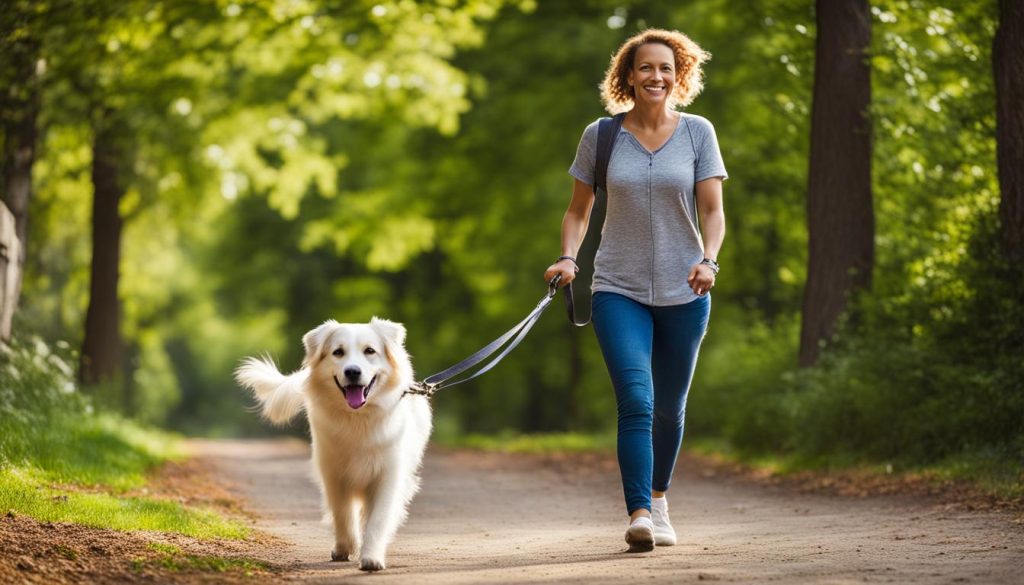
Tips for Consistent and Committed Leash Training
- Set aside dedicated time each day for leash training sessions.
- Use positive reinforcement, such as treats or verbal praise, to reward good behavior.
- Be patient and understanding with your dog, as learning takes time.
- Consistently practice leash training in various environments and situations.
- Stay calm and composed during training sessions, as dogs can sense our emotions.
- Seek professional guidance or enroll in obedience classes if needed.
By following these tips and remaining consistent and committed, you can achieve successful leash training and enjoy stress-free walks with your beloved canine companion.
Final Thoughts
In conclusion, leash training is a process that requires patience, consistency, and positive reinforcement. By understanding why dogs pull on the leash and implementing effective techniques and equipment, such as using the right harness and practicing power steering, you can teach your dog to walk calmly on the leash.
Exercising your dog before walks, training for good leash manners, and setting them up for success all contribute to successful leash training. By ensuring your dog’s exercise and mental stimulation needs are met, you can reduce their urge to pull. Rewarding good behavior with top-quality treats and consistently reinforcing desired behavior will help your dog understand what is expected of them.
To put it simply, consistency and commitment are key. Stay patient and persistent, even if progress is slow. Celebrate small successes along the way and be consistent with your chosen walking method, cues, and rewards. With dedication, you can achieve peaceful, enjoyable walks with your dog and stop them from pulling on the leash.
FAQ
How can I stop my dog from pulling on the leash?
To stop your dog from pulling on the leash, you can try using techniques such as loose leash walking, positive reinforcement, and consistent training. I recommend that you ensure your dog’s exercise and mental stimulation needs are met before starting leash training.
Why do dogs pull on the leash?
Dogs pull on the leash because it is a natural behavior for them. They pull to get where they want to go and engage with their surroundings. Leash pulling can be encouraged inadvertently if the dog is allowed to move forward while pulling.
How do I get started with leash training?
To get started with leash training, begin in a non-distracting environment and use positive reinforcement, such as treats, to reward good behavior. Choose the right equipment, like leashes and harnesses, and be patient and persistent in your training efforts.
Why is consistency important in leash training?
Consistency is crucial in leash training because it helps your dog understand what is expected of them. Stick to one walking method, use the same cues and rewards consistently, and be consistent with your expectations for your dog’s behavior on the leash.
What equipment should I use for leash training?
The right equipment, such as leashes, collars, harnesses, and head collars, can make a difference in leash training. Training collars that rely on causing pain should be avoided due to the associated risks and negative effects. Harnesses, specifically H-Style or Y-style harnesses, can be a great tool for leash training.
How can I use movement to my advantage in leash training?
If your dog pulls on the leash, you can use movement to redirect their attention. Stop immediately and wait for slack in the leash before moving forward, or turn and head in the opposite direction. By changing direction and making yourself more interesting, you can encourage your dog to follow your lead.
Should I exercise my dog before walks?
Exercising your dog before walks can help manage their energy levels and make leash training more effective. Playing fetch or engaging in other physical activities can tire your dog out and reduce their urge to pull on the leash. However, the goal of the walk is to teach your dog to walk nicely, not to provide all their exercise needs.
How can I train my dog to have good leash manners?
Training your dog to have good leash manners requires consistency, patience, and positive reinforcement. Use treats to reward your dog for walking without pulling and reinforce the desired behavior consistently. Set your dog up for success by making it easy for them to do the right thing and be consistent in rewarding their good behavior.
How can I set my dog up for success in leash training?
You can set your dog up for success in leash training by choosing the right time for walks and selecting appropriate routes. Avoid peak hours when your dog may be more excitable and choose quieter times when distractions are minimal. Opt for out-and-back routes instead of circular ones to reduce pulling on the way out.
What is the “cheater method” in leash training?
The “cheater method” involves using a front clip harness, such as the Freedom No-Pull Harness, to aid in leash training. Front clip harnesses provide power steering and prevent dogs from leaning in and pulling. They can be highly effective tools in reducing leash pulling.
What does it take to have successful leash training?
Successful leash training requires consistency and commitment. Be patient and persistent in your training efforts, stick to your chosen walking method, and celebrate small successes. By staying consistent and committed throughout the training process, you can achieve peaceful, enjoyable walks with your dog.
What is the importance of consistency in leash training?
Consistency is essential in leash training because it helps your dog understand what is expected of them. By maintaining consistent cues, rewards, and expectations, you reinforce desired behavior and make training more effective.
How can I effectively stop my dog from pulling on the leash?
To effectively stop your dog from pulling on the leash, employ techniques such as loose leash walking, positive reinforcement, and consistent training. Use the right equipment, exercise your dog before walks, and set them up for success. With consistency and commitment, you can achieve successful leash training.


